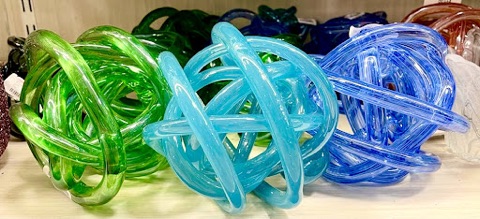Imagine if you could purchase your dream personality in a store? Would you buy “kind,” “whip-smart,” “funny,” “intriguing?”
Decorative objects present virtually the same opportunity; for a few dollars, you can construct a home space that speaks to your lengthy study of Buddhism, your numerous trips around the globe, or your deep interest in Russian literature, all without undertaking an ounce of the effort needed to actually achieve these things.
Decorative objects are a gauntlet of pseudo-art pieces designed to take any home to the next level. They may be a fake marble bust, a nice bronze modernist cube or something living in the space between vase and vaguely-yonnic sculpture. These decorative objects are designed to make your home unique—or as unique as a mass-produced metal sculpture in the shape of a slinky walking down the stairs can be. And they are fascinating in their utter absurdism, in the paradox that they embody, in the ridiculous drive for their existence.
What’s this compulsion of ours to appear better than ourselves? Why do we feel the need to construct a self that’s more interesting, and what does that constructed self represent? At this point, we’re all pretty aware that our virtual selves on social media are constructed and don’t represent the realities of our daily lives. Everyone from celebrities to influencers on Tiktok walk the careful line of curated media between an idyllic, idolized life and keeping it real. Yet we’re less aware of this construction of self in our non-virtual lives.
Aesthetics have virtually replaced traditional clique identities; there’s dark academia, plant mom, e-girl, VSCO girl, cottagecore, goblincore, That Girl…the list goes on. They offer a great starting point for interior design, but they also feed our need to construct our appearances in line with an outside mold of what’s “cool.” We want to give the impression of having our shit together, and if that means wearing chains on our jeans or putting up mushroom magnets on our fridge then by god we’ll do it. Anything for more views, more likes, the projection of an authentic self that’s “not like other girls” while carefully navigating the boundary between what’s “in” and what would be just plain cringe.
The line between the natural curiosity to see why everyone else likes frogs all of a sudden, (and the subsequent onboarding of this interest into our personality) versus when an aesthetic begins to replace our identity is an easy one to blur. After all, personality is fluid and phases aren’t a bad thing at all. But things get trite when we begin to construct a self in our home space that isn’t honest about who we really are. I’m not talking about hanging up posters featuring national parks you haven’t visited simply because you like their vintage look, rather the interior design client who requests that their house be stocked with “books that look good,” not caring what they are and never planning to read them, concerned only with appearing knowledgeable to any houseguests. It’s Gatsby’s library in real life, a cliché example of someone not being who they claim.
We see the difference between the self and the facade clearly in the library of uncut books, but when it comes to our own shopping habits we tuck this disconnect away in the back corner of our minds. When we can’t afford our own homes, the instant gratification of decorative objects has a pseudo-gravitational pull on our sense of self. Ours is a generation that fantasizes about hardwood floors, big windows, a patch of backyard, and our own paint on the walls. We have an increased desire to make our spaces more homey to make up for our lackluster reality filled with student debt, medical bills, and renting wherever we can find. Yet our decorating is low-budget and transient because we don’t have roots anywhere: we’re trying to inject the comfort of home into spaces without the home bit attached.
Low-budget is great for our wallets, and when it takes the vein of low-consumerism it’s also great for our planet. But decorative objects are the opposite of found pieces and upcycling: of course our scraping together becomes commodified and depersonalized. We live in an era where we have the luxury of purchasing an identity at HomeGoods or Ikea—a store-bought, ready-made, pre-packaged self. And don’t get me wrong—I love HomeGoods. But the fact that we can swing by a big box store on our way home, make a few cheap, choice purchases, and reinvent ourselves as a traveling food blogger with an interest in Proust who’s just returned home from their most recent trip to India speaks to our desperation to find comfort in an age of consumerism on a whole new level.
Decorative objects let us build a persona. They make your guests wonder, “Who is my friend?” or better still, think to themselves, “Damn, I really don’t get that art piece. My friend must be so much cooler/ cleverer/ smarter/ more worldly than me.” They fill our free shelves and perch on nightstands and chests of drawers. They draw our acquaintances in, confound our hook-ups, and offer ample opportunity to tell a few white lies about how you found this newest piece while strolling around your favorite bazaar in Morocco.
Speaking of your favorite bazaar in Morocco, let’s talk about appropriation for a second. Stop and consider how more than half of these decorative objects are designed to be vaguely “Indian,” vaguely “African” in nature. The plastic gold Buddha statue (hand sporting a peace-sign), the turquoise-patterned elephant statue, the pink line of camels covered in hearts spelling out “Live, Laugh, Love,” and the “textured oriental wall-hanging” are hollow mimics of the cultures they’re ripping off. Buying a plastic, gold Buddha statue with a cat head to set in your window won’t make you any more enlightened, and your feel-good purchase is hardly an appreciation of anyone’s culture or religion.
It’s this garish construction of self that makes decorative objects so enthralling and appalling: like watching a horrific crash where you can’t look away. I’m not trying to cancel people for having interests and expressing those in their decor—by all means decorate and inspire yourself with places you haven’t been and books you haven’t read yet—but there’s a fundamental difference of intent behind the decorative object. The decorative object is a ready-made identity builder. It says, “I don’t want to do the work, I just want people who visit my house to think I’m cool.” It’s embodied by the strange lurking sculptures of metal tubes we place on our mantels, devoid of all personality yet alluding to our illusive mystique, by the piles of glass orbs and the wooden giraffe—mass-produced to look homemade. We’re avoiding being perceived, yet agonizingly attempting to convince our acquaintances that there’s something about us worth perceiving.
The decorative object is an in-toxic-ating mixture of consumerism and appropriation. It caters to a weird niche of white people seeking “artsy and unique” objects that give off strong exoticism and orientalism vibes. It fills the need to appear different from other people, unique, and trendy. It’s fake, devoid of any real personality, and self-serving. Decorative objects are the appearance rather than the expression of a self.
I know we all have bigger fish to fry than who’s faking having read the classics and traveling to Thailand. Some gatekeep-y article about how we should change our spending habits isn’t going to change anything when, as The Good Place said, there’s no such thing as ethical consumption under capitalism. Of course we want the places we live to be comforting, and of course we want our peers to see us as interesting, unique people with our own secret backstories and alluring agendas. But let’s think about the drive behind our consumption choices. We don’t all have the time and resources to read Proust or travel to India, but those of us that do should strive to make changes to the system with our influence, rather than bask in blame-free resignation. And to construct a self based on appropriation? Not a good look. How are we framing ourselves outside of the virtual? What do the spaces we inhabit tell others about the kind of people we are? Are we being honest with them? Are we being honest with ourselves?





